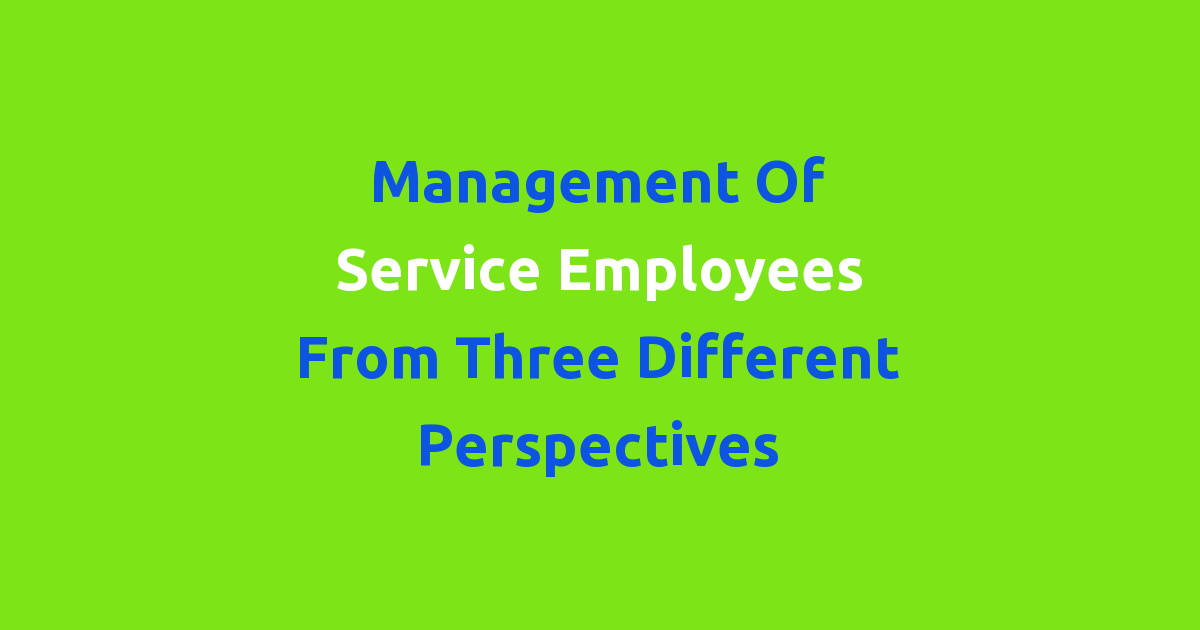1. Supervising service employees from a managerial standpoint involves delegating tasks, providing feedback, and monitoring performance to ensure optimal customer service delivery.
2. Leading service employees requires building strong relationships, fostering a positive work environment, and promoting team cohesion to enhance productivity and customer satisfaction.
3. Supporting service employees involves offering training opportunities, addressing concerns, and recognizing achievements to boost morale and retention rates within the team.
Management of Service Employees from Three Different Perspectives
Introduction
In today’s competitive business environment, the effective management of service employees is crucial for the success of any organization. Service employees play a vital role in delivering high-quality services to customers and maintaining customer satisfaction. However, managing service employees can be challenging due to various factors such as the dynamic nature of service industries, the high level of customer interaction, and the need for continuous training and development. In this project work, we will explore the management of service employees from three different perspectives and propose a new system to improve employee management in the service industry.
Problem Statement
The traditional approach to managing service employees may not be effective in today’s fast-paced and customer-centric service industry. Managers often face challenges such as high employee turnover, low employee engagement, and inconsistent service quality. These issues can have a negative impact on customer satisfaction and ultimately on the organization’s bottom line. Therefore, there is a need to reevaluate the existing system of managing service employees and explore new ways to improve employee performance and satisfaction.
Existing System
The existing system of managing service employees typically involves traditional HR practices such as recruitment, training, performance evaluation, and rewards. However, this approach may not be sufficient to address the unique challenges of the service industry. Service employees often require specialized skills, such as customer service training, conflict resolution, and emotional intelligence. Moreover, the high level of customer interaction in service roles can lead to burnout and job dissatisfaction among employees.
Disadvantages
Some of the disadvantages of the existing system of managing service employees include:
– High employee turnover: Service industries often experience high turnover rates due to job stress, low pay, and limited career advancement opportunities.
– Inconsistent service quality: Employee turnover can lead to inconsistent service quality, which can impact customer satisfaction and loyalty.
– Lack of employee engagement: Traditional HR practices may not effectively engage service employees and motivate them to perform at their best.
Proposed System
To address the challenges of managing service employees, we propose a new system that focuses on employee engagement, continuous training and development, and performance recognition. The proposed system will involve the following key elements:
– Employee engagement: Engaging service employees through regular feedback, recognition, and opportunities for growth and development.
– Continuous training and development: Providing ongoing training in customer service skills, conflict resolution, and emotional intelligence to enhance employee performance and satisfaction.
– Performance recognition: Recognizing and rewarding top performers to motivate and incentivize employees to deliver high-quality services consistently.
Advantages
The proposed system of managing service employees offers several advantages, including:
– Improved employee retention: By engaging and developing employees, the new system can help reduce employee turnover and retain top talent.
– Consistent service quality: Continuous training and performance recognition can lead to consistent service quality, which is essential for customer satisfaction and loyalty.
– Increased employee satisfaction: Engaged and recognized employees are more likely to be satisfied and motivated in their roles, leading to improved performance and job satisfaction.
Features
The new system of managing service employees will include the following key features:
– Employee engagement surveys: Regular surveys to assess employee satisfaction, feedback, and areas for improvement.
– Training and development programs: Ongoing training in customer service skills, conflict resolution, and emotional intelligence.
– Performance recognition program: Rewards and recognition for top performers to motivate and incentivize employees.
Conclusion
In conclusion, the effective management of service employees is crucial for the success of any organization in the service industry. By reevaluating the existing system of managing service employees and proposing a new system that focuses on employee engagement, continuous training and development, and performance recognition, organizations can improve employee retention, service quality, and customer satisfaction. The proposed system offers several advantages, including improved employee satisfaction, consistent service quality, and increased employee retention. Overall, the management of service employees from three different perspectives is essential for achieving success in the competitive service industry.

